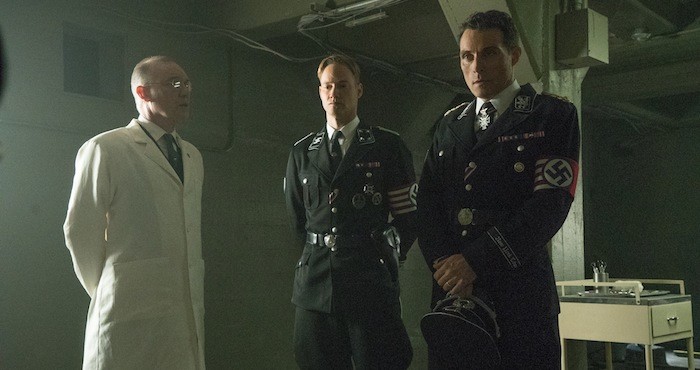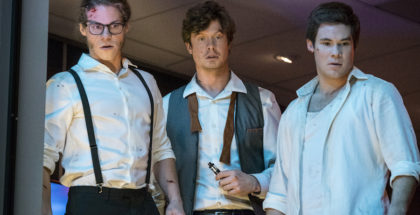Amazon Prime TV binge review: The Man in the High Castle (Episodes 3 to 6)
Review Overview
Cast
8Cutting
9Creepy sense of normality
10David Farnor | On 30, Nov 2015
Read our exclusive interview with Rufus Sewell here.
What would America be like if we lost World War II? Episodes 1 and 2 of The Man in the High Castle impressed immediately with the quality of their world-building, an elegant demonstration of concise exposition: shots of Times Square with neon Nazi symbol; San Francisco bedecked in the flag of Imperial Japan. The show continues to flesh that out in the following four episodes, a process that makes everything seem increasingly normal – and, as a result, even creepier.
Joe (Luke Kleintank) and Juliana (Alexa Davalos) continue to provide our main in-roads into this non-America and their crossed paths in the neutral zone soon put them in danger. Juliana is trying to track down the contact who would have met her dead sister, which gives us more time in the company of Lemmel Washington (Rick Worthy), who runs the diner where she ends up working. There’s never any explicit explanation of what life is like for African-Americans in the post-WWII society – something that’s typical of showrunner Frank Spotnitz and his writing team. Lemmel is, on the one hand, a target because of his role within the resistance and, on the other, shrewd enough not to rule out betraying Jules or the others. Worthy makes the most of that withdrawn poker face whenever he’s on screen.
That ambiguity permeates everyone: just as the occupied nation means its natives’ identities are in limbo, each character adds another shade of grey to the overall universe. The surprise twist at the end of the pilot that Joe (Luke Kleintank) is working for John Smith (Rufus Sewell), for example, soon becomes turned on its head once again, thanks to his apparent feelings for Juliana – a swift sign that nobody’s every really able to be trusted.
That uncertainty means that the few people who are cast-iron in their motives really stand out. Top of the list is the Warden, who swans about the neutral zone in cowboy boots and a stetson, a self-appointed sheriff to uphold values that would, we suppose, be deemed patriotic. Burn Gorman is deliciously good as the killer, all confidence and clarity. “I’ll burn ’em,” apologises Carl, who sold a Bible to Jules the episode before. “That is your name, right?” asks the Warden. “Carl?” He tilts his head. “You sure?”
Gorman moves with a horrible swagger, his grimacing face wiped by his hands with the kind of cartoonish menace the actor has made a trademark. But he’s never too over-the-top to break the show’s believable spell, partly thanks to him sparking one of the most adrenaline-fuelled set pieces of the series so far. It’s a reminder of how well paced this first season is. Amazon has a habit of embracing binge-viewing in a more natural way than Netflix; its episodes stop and start seamlessly. Even when it cuts into the chase sequence with the Warden, the cliffhanger doesn’t feel forced; more like a pause for you to turn the page.
The Warden is not the only villain in the show, though: alongside John in the East, we have Inspector Kido (Joel de la Fuente) on bad guy duties in the West. He’s contrasted beautifully against Frank (the movingly tragic Rupert Evans), who struggles to adjust to life after being released from Japanese custody – only to discover that intelligence officers have already killed his sister and her kids. “You ever need any more Jews to kill, then you know where to find me,” he spits at Kido with quivering anger. “Yes,” comes the calm, chilling reply. “I do.”
If the juxtapositions are what highlight the menace of this brave new world, The Man in the High Castle excels at highlighting the parallels that exist. As Frank considers killing for revenge – even fashioning a working gun at his factory – Jules finds herself dealing with the consequences of having overstepped the moral mark of murder. (Frank’s gun, notably, is modelled after a Smith & Wesson revolver; the kind of weapon brandished by US heroes in Westerns; the sense of how what’s presented to us on screen in TV and films can influence our worldview is layered into the tiniest of details.) Or later, as Joe and Jules go their separate ways, she finds herself working for the Japanese, while Joe is taken under Smith’s wing even further; shots of them snooping through their masters’ filing cabinets are cross-cut with subtle suspense by editor Jon Dudkowski (Mud’s Julie Monroe also does fantastic work in the chopping room).
It’s that kind of elegant structuring that helps to bring coherence to this bizarre reality – it’s incredible just how quickly we take it all for granted, especially when you consider how unconvincing some shows set in the same world as us can be. Songs like Summertime, meanwhile, play in the background, often heard on the radio in both halves of the country, just to help anchor events in something recognisable. And yet everything is shot with a slight haze, accentuating the strangeness of it all. It’s no coincidence that episodes have titles such as “The New Normal”.
Philip K. Dick’s novel, of course, has already done part of the work in blurring the boundary between fact and fiction, with characters such as Rudolf Wegener echoing the name of Nazi physician Friedrich Wegener, and Hitler name-dropped regularly. Wegener, we soon discover, is attempting to pass atomic secrets from Germany to the Japanese science minister, something that Smith is, naturally, dead against. He and Wegener, though, go way back, all the way back, in fact, to the concentration camps.
Nobody talks about the Holocaust, says Rudolf, as he comes round to their house for dinner. “It was necessary,” offers Smith. “At least we have better whiskey,” jokes Wegener, with less conviction. “We have a better world,” comes the sharp reply.
Sewell remain the most striking character of all, his Obergruppenfuhrer intimidating but astonishingly complex. Scenes where he tries to interrogate a prisoner find him frustrated by the Nazi’s use of opiate drugs to pacify them. “You’re an angel,” gushes Smith’s captive. “This man tries to kill me and we reward him with an oceanic experience,” John snaps.
That dark humour, annoyance and ruthless resolve would be enough to make him an engrossing villain, but what’s really effective is that we see these things from Smith’s perspective. Rufus Sewell has a natural charisma, but also a passionate belief in his delivery that makes it easy to watch and support this Nazi officer. Scenes with his family, where he both scalds and encourages, make him a human first and a monster second. And yet he remains permanently in control: part of his demeanour, you suspect, is an act to manipulate those around him. Does he really care for the orphaned Joe, as a pseudo-son figure, or is he merely playing him like a pawn?
While a similarly dubious common ground is established between Jules and Mr. Tagomi over in San Francisco, it all comes to a head with VA Day celebrations in the West, an occasion the Japanese don’t honour – a significant split in a show where so many things overlap. With Joe at Smith’s for a family meal, we get immersed in this eerie non-tradition, as Americans smile and wave at their neighbours, all saying “Sieg Heil” as a friendly, casual greeting. It’s in these literal interactions that The Man in the High Castle becomes unlike anything else around: it’s a marvellous piece of alienation through the presentation of something things that are familiar. “Sacrifices have to be made,” states Sewell, impossible to read but impossible to doubt that he knows exactly what he’s doing. Fireworks go off in the background. What would America be like if we lost World War II? What’s amazing about Amazon’s The Man in the High Castle isn’t that it asks such a troubling question, but that it gives us such a scarily convincing answer.
All 10 episodes of The Man in the High Castle are available to watch online exclusively on Amazon Prime Video, as part of a £5.99 monthly subscription – or, if you also want free next-day delivery and access to Spotify rival Prime Music, a full £79 annual Amazon Prime membership.


















